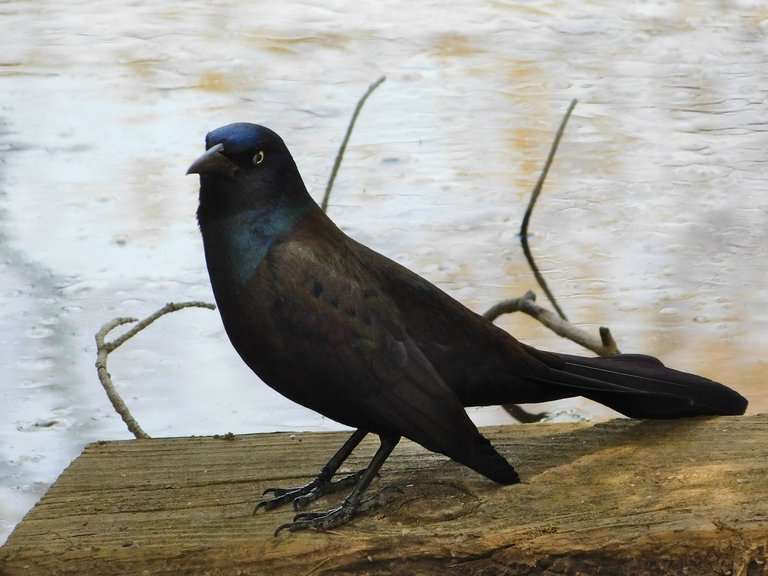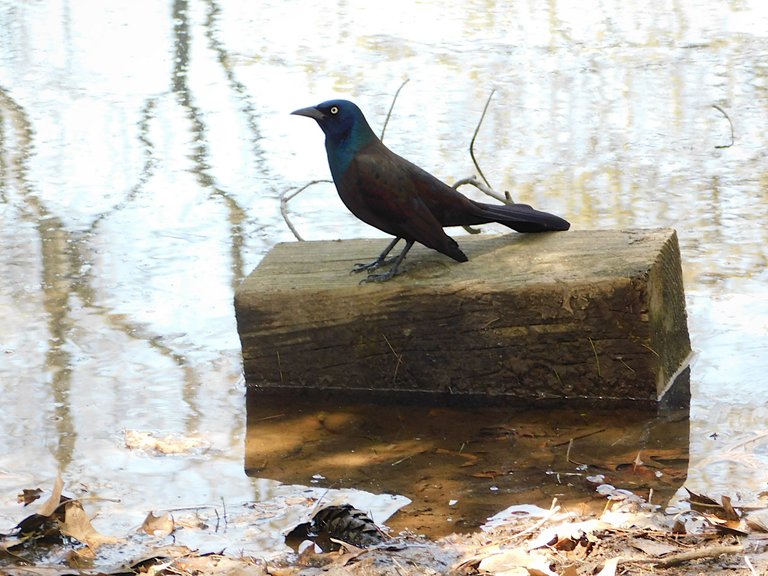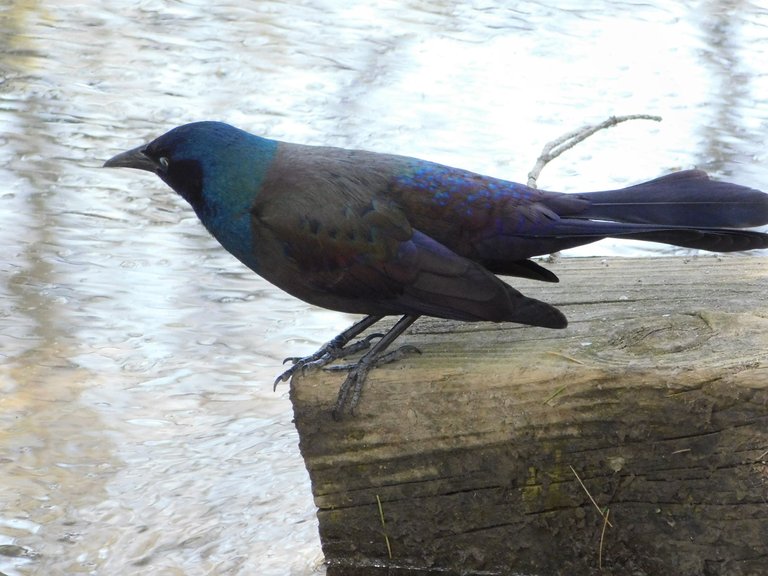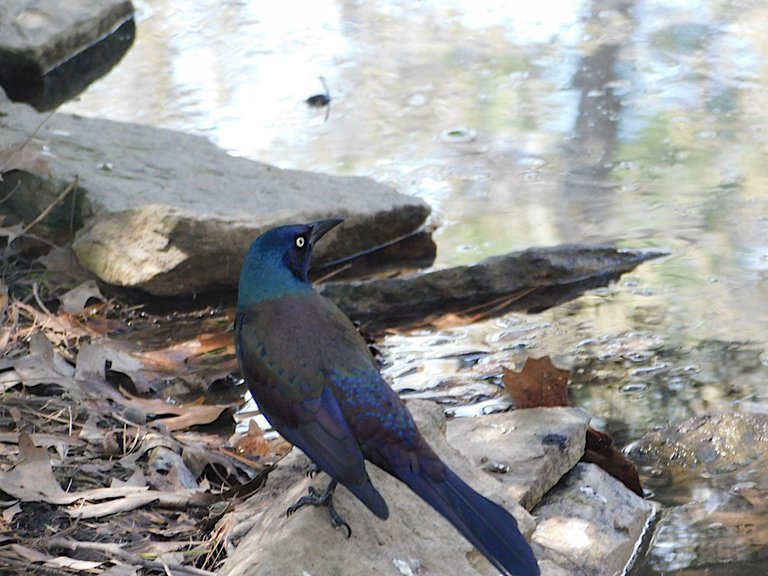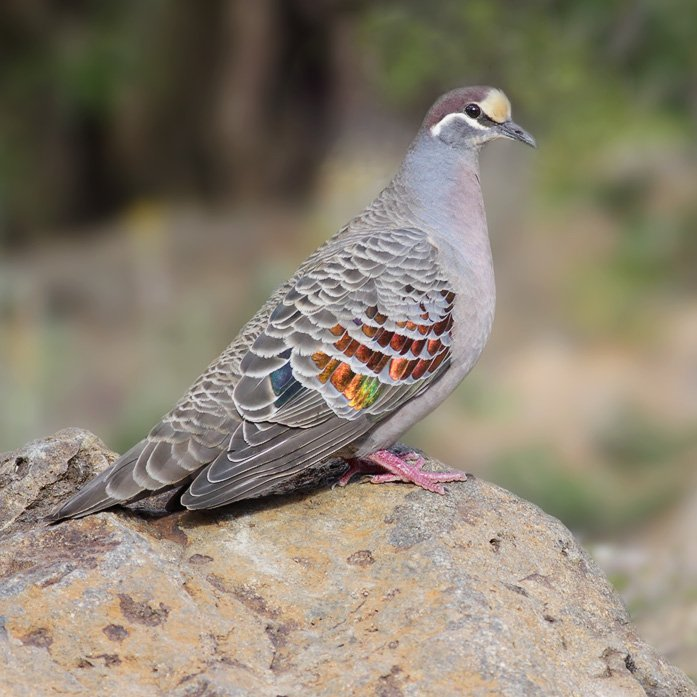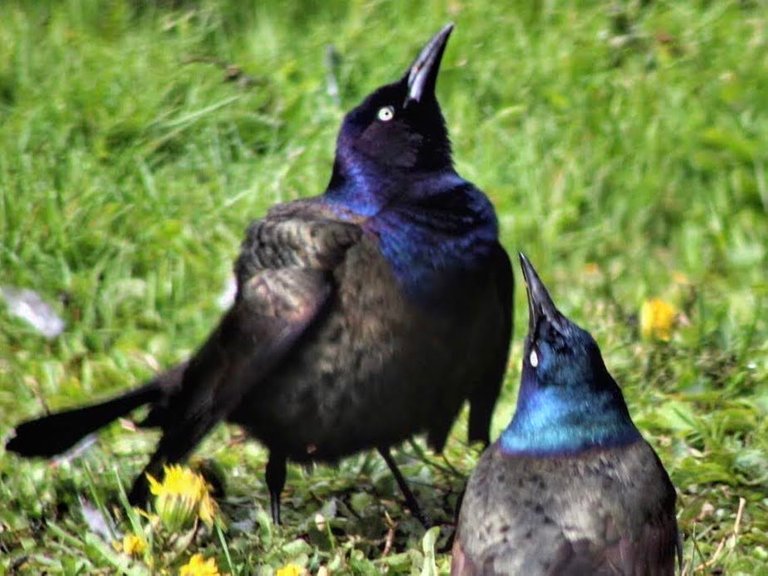It was 85 °F in my area today, so of course my husband and I went to one of our favorite outdoor attractions: Clark Botanical Garden. We were well rewarded there with blooming plants and animals busy getting into their spring routine. One of our favorite spots in the Garden is a pond where turtles sunbathe and humans rest on welcoming benches.
As we approached the pond I heard a distinctive bird call. I looked down and saw, quite close to me, a beautiful blackbird. The bird was not distressed by my presence.
Bird Looking Directly at Me
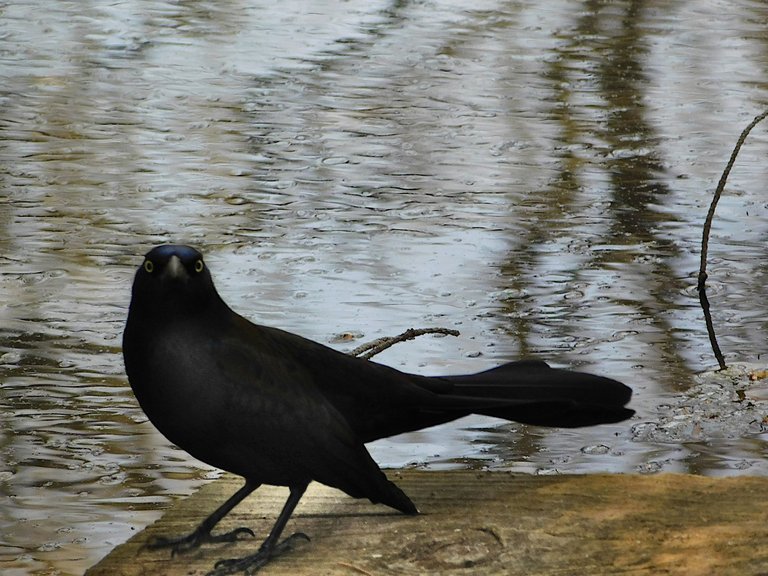
@agmoore
I don't know much about birds, so I couldn't identify this one. I did notice there were others of the same variety in the gardens. I have seen this type of bird before in the community. Later in the afternoon, I looked up descriptions of blackbirds found in the area and decided I had definitely met a grackle that morning.
Common Grackle (Quiscalus-quiscula),
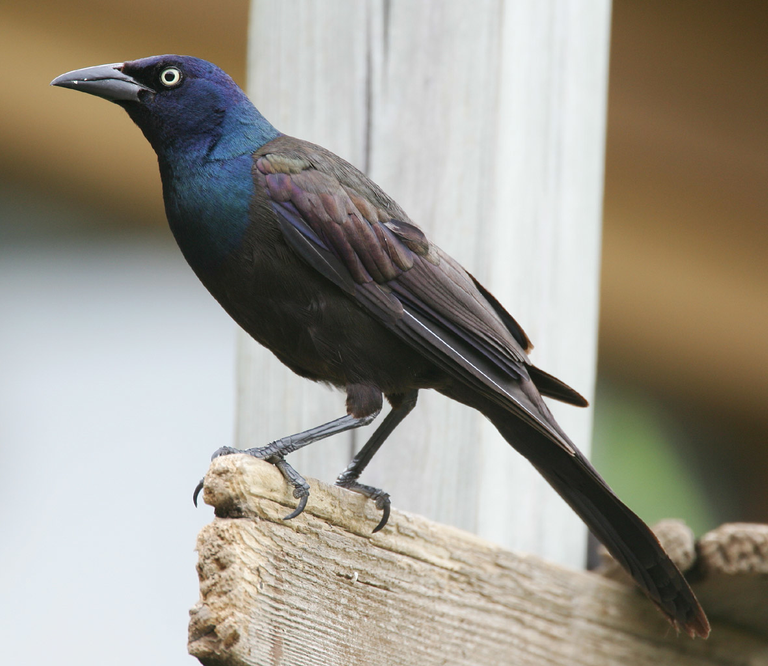
Credit: Mdf. Used under Creative Commons Attribution-Share Alike 3.0 Unported license.
The bird was cawing persistently. The call sounded something like this:
The call was rather persistent. Here is one of the first shots I took of him (yes, it is a him, and I'll explain later). I approached cautiously because I didn't want him to fly away.
But, as you can see from the numerous photos I snapped, he tolerated my approach. Here is one picture where he seems to be listening but not reacting to my presence.
How do I know this bird is a male? According to allaboutbirds.org, the Common grackle is dimorphic, which means males and females can be distinguished by their appearance. Males have glossier, larger bodies and longer tails than females.
Here is a Youtube video of a female and male engaged in a mating dance
And, here is a description: of the Common grackle:
Common Grackles are large, lanky blackbirds with long legs and long tails. The head is flat and the bill is longer than in most blackbirds, with the hint of a downward curve.
The Common grackle has a noticeable bright golden eye. The effect is to give the bird an intent expression. Also, the shape of the grackle's tail is quite distinctive. It is long and 'keel-shaped'. While these birds are known for the iridescence of their feathers (especially the males) they can appear quite black in certain light. Note, for example, the second picture in this blog and the one below this paragraph.
While the Common grackle is a blackbird with an iridescent, almost violet sheen, I saw one that had a bit more blue and wondered if this was usual.
I checked the Internet and found a picture of one that looked almost exactly like the one I spotted (Fourth picture down on the referenced page).
The grackle is, in fact a member of the New World blackbird family (Icteridae). This family includes more than a hundred species and are called New World blackbirds because they are only found in the Americas.
It is believed that the Icteridae evolved in South America and then differentiation occurred across all of the Americas. Grackles and related birds are one of five distinct lineages that evolved from the original Icteridae.
Brown-headed Cowbird (Molothrus)

Credit:Rhododendrites. Used under Creative Commons Attribution-Share Alike 4.0 International license. One of the birds related to the grackle that evolved in the same lineage.
Rear View of Grackle at the Botanical Garden, With Bluer Hue
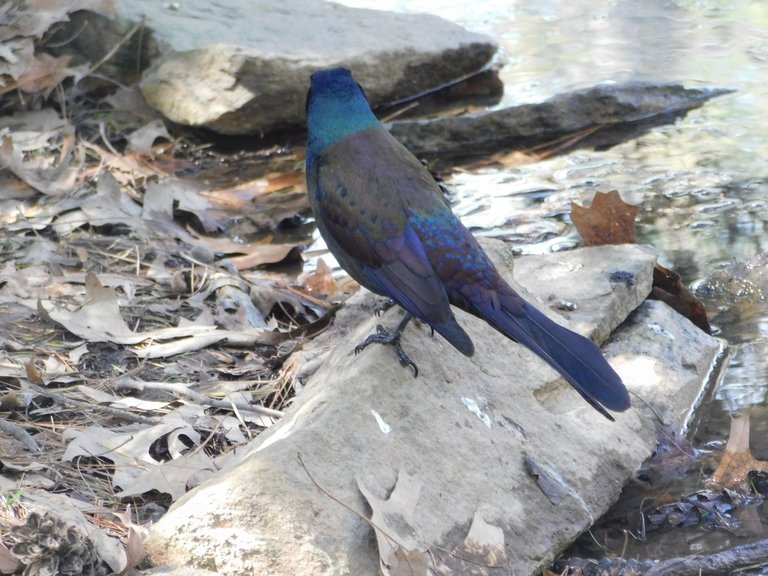
@agmoore
The Common grackle may have a lifespan of approximately 17 years and has been known to live 22 years. This is considered unfortunate by some who view the grackle as a pest. According to the U. S. Department of Agriculture the grackle consumes livestock feed, destroys crops, damages property, spreads pathogens and collides with aircraft. The birds number in the tens of millions.
The Common grackle is often not welcome because of its opportunistic eating habits. In warm weather it may eat crops. In other circumstances it may dominate bird feeders. In the winter it will eat seeds. It also feeds on insects and may steal from other birds' nests.
The Common grackle not only has a long lifespan, but these birds are also successful breeders.
Here is a Youtube video of a mother feeding her nestlings.
I consulted several sites about the Common grackle's mating habits. Most describe the birds as monogamous, mating for life. Some describe them as serially monogamous. Some sites state that the male will occasionally stray and mate with another female.
After mating, the pair will build a nest together and apparently the male remains quite vigilant around the female. It is suggested that this is to make certain another male will not also mate with the female.
Both parents cooperate in the care of the young. There is usually only one brood produced in a year. There may be as few as 2 or as many as 6 eggs in a nest, usually between 4-5. Common grackles generally nest in colonies. Females incubate the eggs but both parents feed the young.
It has been observed that males may assist in feeding the young in other nests. Although one site asserts that half the male grackles abandons the female after she has begun incubating the eggs.
Male Common Grackle at the Botanical Garden
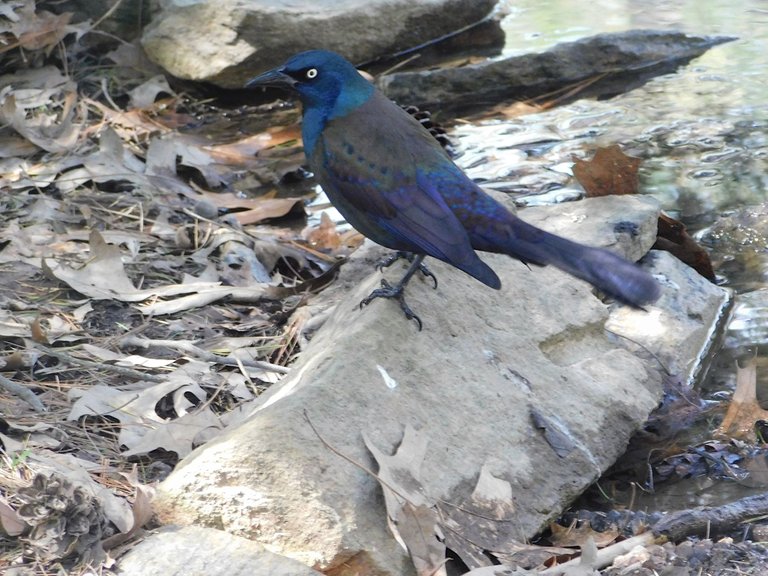
@agmoore
While in this blog I have described and discussed the Common grackle, there are actually three kinds of grackle in North America: Common Grackle, Boat-tailed Grackle and Great-tailed Grackle. The Common Grackle is the most widely dispersed of the three. In all the Americas, there are eleven species with this name (one is extinct).
Boat-tailed Grackle, Florida, USA
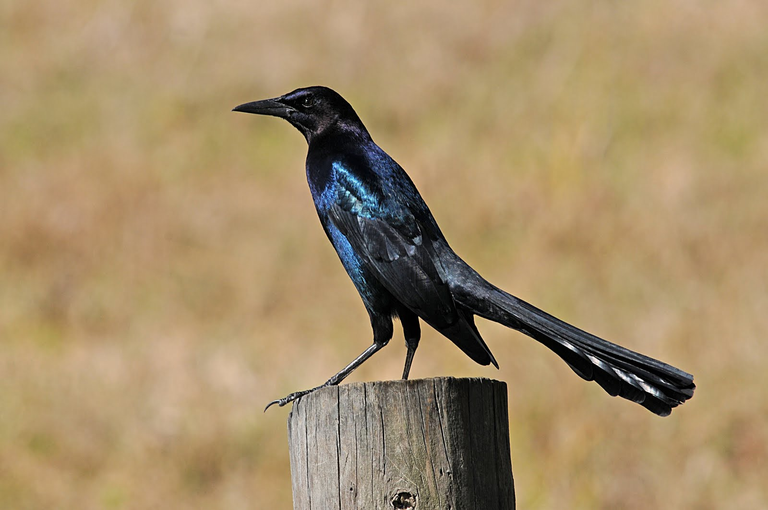
Credit: Connie Denyes, from Picasa Web Albums. Used under CC Attribution 3.0 Unported license
Conclusion
The Common grackle may be a pest to some people, but it is a beautiful bird. I hope you have enjoyed this brief introduction. I certainly enjoyed making this bird's acquaintance.

End Illustration
@yaziris from the LMAC Image Library, LIL (Bird)
@muelli from the LMAC Image Library, LIL (Flowers)
https://www.allaboutbirds.org/guide/Common_Grackle/id
https://abcbirds.org/bird/common-grackle/
https://urbannature.blog/2018/02/01/consider-the-grackle/
https://www.oiseaux-birds.com/page-family-icteridae.html
https://www.labirders.org/webinars/icterids.html
https://www.encyclopedia.com/environment/encyclopedias-almanacs-transcripts-and-maps/new-world-blackbirds-and-orioles-icteridae
https://avitrol.com/pages/bird-facts/grackle/avitrol-grackle-life-span.html
https://www.birdinformer.com/field-guide/common-grackle/
(https://www.birdwatchingdaily.com/beginners/getting-started/coping-with-grackles/
https://www.aviaway.com/grackle
https://animalia.bio/common-grackle
https://animaldiversity.org/accounts/Quiscalus_quiscula/
https://www.audubon.org/field-guide/bird/common-grackle
https://www.birds-of-north-america.net/grackles.html
https://en.wikipedia.org/wiki/Grackle
